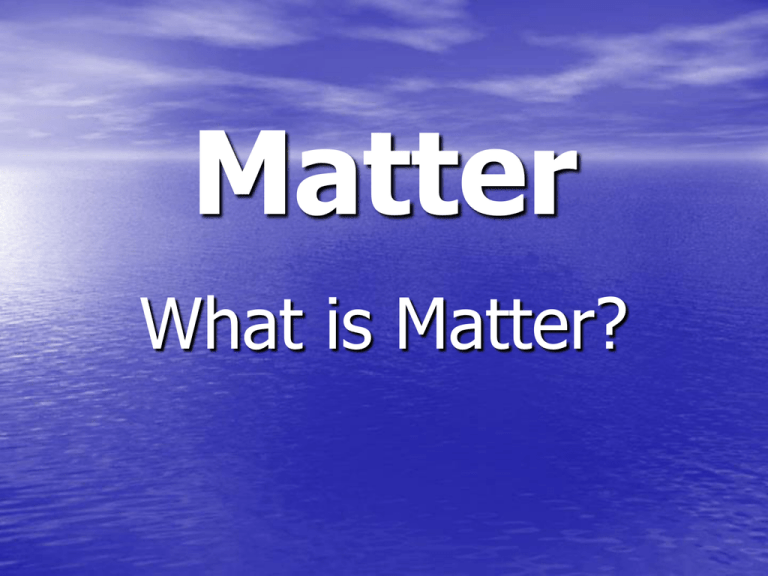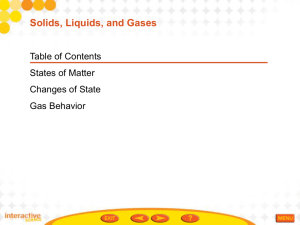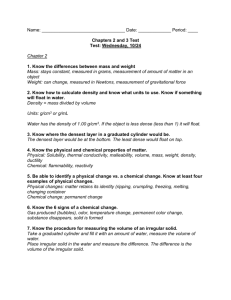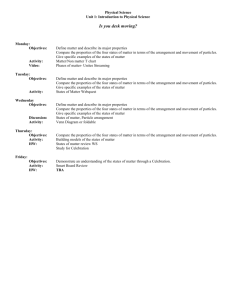Properties of Matter
advertisement

Matter What is Matter? Matter • Matter is what the world is made of. • Matter has mass and volume • All objects consists of matter. Mass • A measure of the quantity of matter in an object • Measured by grams (g) and kilograms (kg) • Doesn’t change due to location Weight • Weight is the response of mass to the pull of gravity. Metric unit of weight is the Newton (N). • Does change due to location Mass vs. Weight • Weight = mass x acceleration of gravity • Mass kg X 9.8 m/s2 = Weight (on earth) N • What is your weight on earth? (Remember 1 kg = 2.2 lbs) What is your weight on earth? • mass X 9.8 m/s2 = Weight (on earth) • (Remember 1 kg = 2.2 lbs) Volume • The amount of space an object takes up is called its volume. • Volume is measured in liters (L), milliliters (mL), and cubic centimeters (cm3) Chemistry • The study of matter and how it changes Element • A substance that cannot be broken down into simpler substances • Everything is made of elements Atom • Smallest particle of an element • Has all the properties of that element • Unique Molecule • Smallest unit of a compound that exhibits all the properties and characteristic of that compound Element •a substance that cannot be broken down into simpler substances Compound • A substance made of atoms of more than one element bound together 2.6 Earth's Composition Earth’s Composition 1.9 1.1 2.4 Iron 12.7 34.6 Oxygen Silicon Magnesium Nickel 15.2 Sulfur Calcium All other elements 29.5 Chemical Formula • Chemical symbols and numbers indicating the atoms contained in the basic unit of a substance • A formula that represents one molecule of a compound • Empirical formula is the simplest formula of a compound • Molecular formula is a simple multiple of its empirical formula 0.40% Elements in the Human Body 0.90% 1% in0.20% Elements the Human Body 1.60% 0.30% 2.40% Oxygen Carbon 10.20% Hydrogen Nitrogen Calcium 17.50% Phosphorus Potassium 65% Sodium Sulfur All other element Chemical Formula • Examples C16H10N2O2 Indigo C12H22O11 Sugar Classifying Matter Classifying Matter Classifying Matter Classifying Matter Classifying Matter Classifying Matter Classification of Matter Pure Substance • Any matter that has a fixed composition and definite properties Mixture • A combination of more than one pure substance • Blending together of pure substances Mixture • Homogeneous Same kind Uniform in structure or composition throughout Mixture • Heterogeneous Different kinds Not complete mixed Consists of dissimilar elements or parts Marble Mixtures • Miscible Able to dissolve into each other in various proportions Mixtures • Immiscible describes two or more liquids that do not mix into each other Oil and Water Platform Holly Oil Spill November 1981 Matter Matter and Energy Matter and Energy 1. Think about the properties of ice. It is somewhat hard and cannot be compressed easily. Which drawing do you think represents a solid? Why? Matter and Energy 2. Think about the properties of gases. They are not hard, and they can be compressed. Which drawing represents a gas? Why? Matter and Energy 3. In which state(s) of matter are the particles touching? Matter and Energy 4. In which drawing do you think the particles have the least effect on one another? Why? Kinetic Theory • All matter is made up of atoms and molecules that act like tiny particles • Tiny particles are always in motion. The higher the temperature the faster they move • At the same temperature heavier particles move slower than lighter particles States of Matter • Four phases of matter Solid Liquid Gas Plasma Gases • Do not have a regular shape • Nor a regular volume • Take on the shape of their container Particles of a Gas • Move fast enough to overcome nearly all of the attraction between them • The particles move independently of one another Gas Pressure • Force exerted per unit area on a surface •P = F / A Pressure • Gas particles exert pressure by hitting the walls of a balloon. • The balloon pops because the internal pressure is more than the balloon can hold. Liquids • Have a definite volume • Do not have a definite shape • Take on the shape of their container • Viscosity The resistance of a liquid to flow Particles of a Liquid • Move fast enough to overcome some of the attraction between them • The particles are able to slide past one another Liquid Solids • definite shape • definite volume • Crystalline Solids In many solids, the particles are arranged in a regular, repeating pattern called a crystal. (i.e. salt, quartz) Crystals Solids • Amorphous solids lose their shape under certain conditions •(i.e. tar, candle wax, glass) Amorphous Solids: Candle Wax Particles of a solid • Do not move fast enough to overcome the strong attraction between them • So they are held tightly in place. • The particles vibrate in place. Plasma • Rare on earth. (lightning) • Most common phase in the universe • Stars, like our Sun • Matter in plasma phase is high in energy, and is dangerous to living things Plasma Plasma Energy • Ability to change or move matter Phase Changes • Melting • Freezing • Vaporization • Condensation • Sublimation Phase Changes are Physical Changes Melting • The change from solid to liquid Freezing • Liquid To Solid • When a liquid loses heat energy Liquid to Gas • Vaporization change from a liquid to a gas • Evaporation Vaporization at the surface of a liquid Boiling • Process by which particles inside the liquid travel into the air. Condensation • The change of a substance from a gas or vapor to a liquid Sublimation • To change phase (from a solid or gas) without becoming a liquid Vaporization • To be converted from a liquid into vapor/gas Evaporation • Vaporization that occurs at the surface of a liquid Changes of State Graph For Water Conservation of Mass Law of Conservation of Mass • Mass cannot be created or destroyed Law of Conservation of Energy • Energy cannot be created or destroyed Matter Properties of Matter Section 2.3 Chemical Properties • describes the way a substance reacts with others to change into a different substance Chemical Changes Reactivity • the ability of a substance to combine chemically with another substance Physical Properties • characteristics that can be observed or measured • without changing the identity of the object. Shape, color, odor, texture… Melting Point • Temperature at which a solid changes to a liquid. • Aluminum M.P. = 660 °C 0 • 0 C for water at sea level Freezing Point • Temperature at which a liquid changes to a solid • Water F.P. = 0 °C at sea level Boiling Point • Temperature a liquid boils at. • B.P. of a liquid is related to pressure above it. • Water BP = 100 °C • Table Salt BP = 1413 °C • Diamond BP = 4200 °C General Properties of Matter include • Mass • Weight • Volume • and density Density • Density is the mass per unit volume Density • density = mass / volume Or DMV • Units Mass – g Volume – cm3 Density – g/ cm3 Problem • If 96.5 grams of gold has a volume of 5 cubic centimeters, what is its density? Solution • Step 1 Write the formula d=m/v • Step 2 Substitute given numbers and units d = 96.5 g/ 5 cm3 • Step 3 Solve for unknown variable d= 19.3 g / cm3 Practice Problems • 1. If 96.5 grams of aluminum 3 cm , has a volume of 35 what is the density of aluminum? • 2. If the density of a diamond is 3.5 g / cm3, what would the mass be if the volume is 0.5 cm3? Solution • Step 1 d=m/v . • Step 2 rearrange d v= m • Step 3 Substitute given numbers 3 . g/cm 3 .5cm and units 3.5 =m • Step 4 Solve for unknown variable m= 1.75 g Buoyancy • The force with which a more dense fluid pushes a less dense substance upward. Archimedes’ Principle • The buoyant force on an object is equal to the weight of the fluid displaced by the object. • Therefore if an object increases it’s density it will sink, and if decreases it’s density it will float. Density Lab Does it Float? Does it Float? • The density of water is 1 gram per milliliter, 1g/mL. • If the object’s density is greater than 1g/mL, then the object will sink. • If the object’s density is less than 1g/mL then it will float. Does it Float? • In this activity you will measure the mass and volume of several objects to obtain their densities. • density = mass / volume • Volume of cube=length x width x height • Volume of cylinder=p r2 h Remember 1 cubic centimeter = 1 mL Volume of Cylinder • Volume = p r2 h Volume of a Cube • Volume= L x W x H Lab Report Format Descrip Mas Volu Densi Does tion s me ty it (g) (mL) (g/m float L) ? •What Quiz kind of solid is in the picture? Quiz •What kind of matter phase is in the picture? Name the Phase Name the Phase Name the Phase Name the Phase Gas – Pressure, Temperature and Volume • Boyle’s Law – if volume is reduced, pressure will increase. P1V1 = P2V2 or P1/P2 = V2/V1 • Charles’s Law – if temperature of a gas changes but pressure is the same, then volume of the gas changes. T1V2=T2V1 or T1/T2=V1/V2







